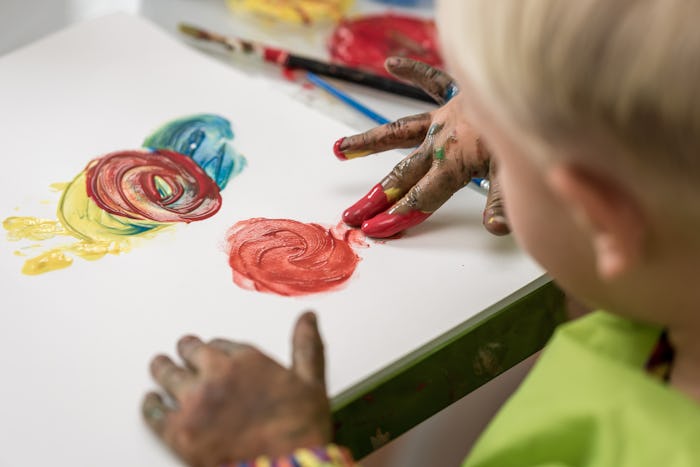When you have a little one, it’s so fun to imagine what they'll be like when they get older. Will they enjoy baseball or painting? Will they be adventurous or picky eaters? Even more basic preferences are up for grabs. Like, when will you know your child's dominant hand?
If you're still in the young toddler stage, you'll likely be waiting for some time before you find out. Charles Pelshaw, M.D., pediatric physiatrist and Division Chief of Physical Medicine and Rehabilitation at Children’s Hospital of Michigan, told Romper that most children don’t establish a dominant hand until they’re a few years old.
“They did studies back in the 1980s, and found that fetuses as early as 13 weeks tended to suck one thumb over the other thumb, so there may be some handedness established earlier than we even know. Generally, a child, after they’re born, should not have handedness firmly established until age 3 to 3-and-a-half years. A child may use one hand more than the other, but still not have definitive handedness decide until 3,” he says.”
Pelshaw adds that babies normally use both hands while developing their general motor skills. That changes after 18 months of age.
“Between 18 months and age 3 to 3-and-a-half, they’re going to tend to start using one hand a little more than the other. Most times they may use their right hand, and occasionally the left.”
In an interview with Romper, Ashley Binkowski, MS, OTR/L, an occupational therapist at Children's Hospital of Philadelphia, provided some activities parents can try with their kiddos to develop their motor skills leading up to the age where one hand takes center stage.
“There are a lot of activities that you can engage your child in to help with motor skill development: fine motor activities, everyday activities, and gross motor activities,” Binkowski says. “Fine motor activities that can help are drawing, coloring, cutting with scissors, building with Legos or blocks, threading activities, puzzles, and playing musical instruments. Try gross motor activities, such as sand pit activities, holding tennis rackets, or throwing balls and beans bags.”
Some of the everyday activities known to advance a little one’s motor skills include brushing teeth and hair, zipping up backs and pencil cases, removing lids from containers, helping wash dishes, or helping prepare snacks, like sandwiches. Binkowski adds that if your child isn’t showing preference for one hand or the other, just let them be.
“It is important to know that if your child does not have a preferred hand, do not force them to use a hand. Rather, observe your child during activities that occur every day, like coloring, eating, or brushing teeth,” she explains. “Yes, they could be ambidextrous, but only about 1 percent of the population is. Sometimes, children that use both hands equally older in age may have motor planning issues or difficulties crossing one side of their body over to the other. It’s important to bring these concerns up with your pediatrician, as a consult with an occupational therapist may be warranted.”
Pelshaw explains that while taking some extra time to develop handedness is OK, seeing one hand doing all the work before the toddler years should be a red flag for parents.
“If a parent identifies that their child is only using one hand, they should be evaluated by a pediatric neurologist. Don’t always offer something to one hand, offer things from both sides so they have the opportunities to use those skills on both sides. There’s still so much to be learned about brain and spinal cord development."
So if your little one is using one hand strongly and avoiding the other before 18 months, it's definitely something to bring up with your doctor. Otherwise, Pelshaw says, "We encourage parents to be observant of their children and to help them practice using both hands — that’s the best thing we can do.”
Experts:
Charles Pelshaw, M.D., pediatric physiatrist and Division Chief of Physical Medicine and Rehabilitation at Children’s Hospital of Michigan
Ashley Binkowski, MS, OTR/L, an occupational therapist at Children's Hospital of Philadelphia
